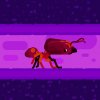Yes! Those are much better pictures!
These are undoubtedly Solenopsis molesta, one of my favorite species to keep in captivity.
Thanks! I'm curious what makes them one of your favorites? Given the size of these queens, I'm imagining some small workers. Are they able to sting like the Solenopsis richtori I regularly find around our neighborhood?
Good questions 
Solenopsis molesta, thief ants, are very unique. They're called 'thief' ants because they specialize and excel in raiding the nest of nearby colonies, in order to steal brood to feed on. They are fairly common, but they are rather hard to find in my opinion. Similar to most very small ants (with the exception of Monomorium and a few others), these ants are relatively inconspicuous and it's not easy to find as many workers foraging as you may with Lasius or Tetramorium species.
My favorite species to keep all happen to be members of the Myrmecinae subfamily; they seem to be less picky about conditions and a little more hardy. Thief ant stingers are not nearly large enough to actually puncture your skin, but they are aggressive nonetheless! This is one of the reasons I like them; typically, invasive genera like Tetramorium and Solenopsis are happy with whatever resources they can get, and native, more delicate species like Prenolepis imparis and Brachymyrmex depilis have slightly steeper preferences.
Also, I tend to be the kind of person to admire the aesthetic and visual aspects of ant castes, so I appreciate their miniature body sizes and bright orange, shiny coloration.
Good luck with these, you should consider starting a journal if you plan on keeping them long-term. I'd recommend checking out some of Aaron's or Nathan's journals if you're unfamiliar with the concept. Most of the journals there are pretty professional and impressive, so you could really look at any of them. I do hope these queens do well, I don't know too many people who actually keep Solenopsis molesta.





















